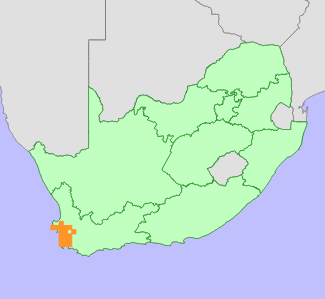|
Scientific Name | Muraltia macropetala Harv. |
Higher Classification | Dicotyledons |
Family | POLYGALACEAE |
National Status |
Status and Criteria | Vulnerable B1ab(ii,iii,v)+2ab(ii,iii,v) |
Assessment Date | 2018/10/01 |
Assessor(s) | N.A. Helme, D. Raimondo & L. von Staden |
Justification | Muraltia macropetala is a range-restricted, but formerly common species with an extent of occurrence (EOO) of 8234 km². It has declined extensively due to more than 70% habitat loss. The remaining population is severely fragmented, and continues to decline due to ongoing habitat loss and degradation. It is therefore listed as Vulnerable under criterion B. |
Distribution |
Endemism | South African endemic |
Provincial distribution | Western Cape |
Range | This species is endemic to South Africa, and is found from Hopefield to Faure. |
Habitat and Ecology |
Major system | Terrestrial |
Major habitats | Cape Flats Dune Strandveld, Saldanha Granite Strandveld, Swartland Shale Renosterveld, Peninsula Shale Renosterveld, Swartland Granite Renosterveld, Swartland Silcrete Renosterveld, Swartland Alluvium Renosterveld, Boland Granite Fynbos, Hangklip Sand Fynbos, Cape Flats Sand Fynbos, Atlantis Sand Fynbos, Hopefield Sand Fynbos, Swartland Alluvium Fynbos |
Description | It occurs in sandy loams and clay flats in renosterveld. |
Threats |
| Muraltia macropetala has lost more than 70% of its habitat to agricultural and urban expansion, and loss continues. Most remaining subpopulations occur on small, isolated remnants where they are threatened by ongoing habitat degradation due to overgrazing and inappropriate fire management. Much of this species' remaining habitat is infested with unmanaged alien invasive plants. |
Population |
This historically widespread and common species has declined extensively across its range, but recent field observations confirmed that it still persists in at least 30 locations. Nearly all of these are small fragments, and subpopulations are small. Therefore the population is considered severely fragmented. It continues to decline due to ongoing habitat loss and degradation.
|
Population trend | Decreasing |
Assessment History |
Taxon assessed |
Status and Criteria |
Citation/Red List version | | Muraltia macropetala Harv. | VU B1ab(ii,iii,v) | Raimondo et al. (2009) | |
Bibliography |
Goldblatt, P. and Manning, J.C. 2000. Cape Plants: A conspectus of the Cape Flora of South Africa. Strelitzia 9. National Botanical Institute, Cape Town.
Manning, J.C. and Goldblatt, P. 2012. Plants of the Greater Cape Floristic Region 1: The Core Cape Flora. Strelitzia 29. South African National Biodiversity Institute, Pretoria.
Raimondo, D., von Staden, L., Foden, W., Victor, J.E., Helme, N.A., Turner, R.C., Kamundi, D.A. and Manyama, P.A. 2009. Red List of South African Plants. Strelitzia 25. South African National Biodiversity Institute, Pretoria.
|
Citation |
| Helme, N.A., Raimondo, D. & von Staden, L. 2018. Muraltia macropetala Harv. National Assessment: Red List of South African Plants version 2024.1. Accessed on 2025/10/31 |
 Comment on this assessment
Comment on this assessment


